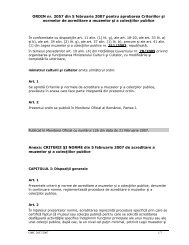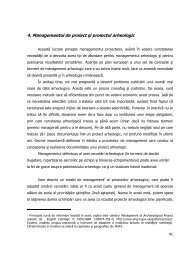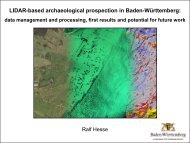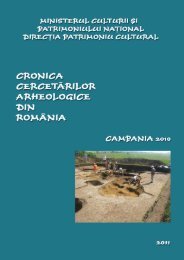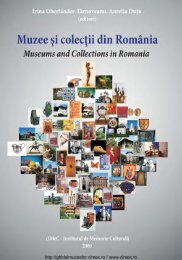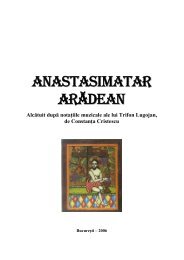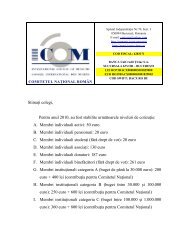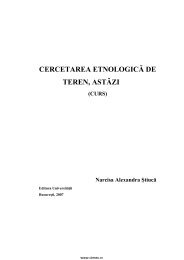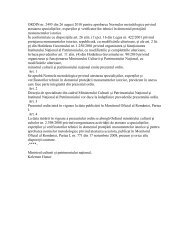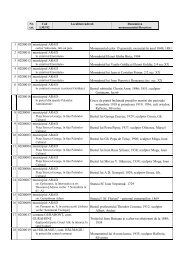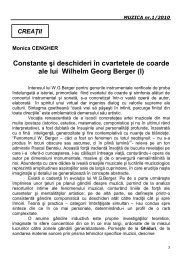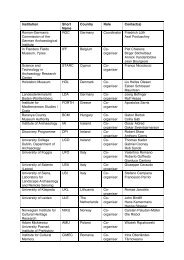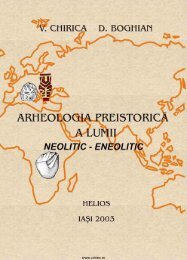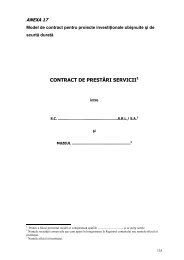pdf (15 MB) - cIMeC
pdf (15 MB) - cIMeC
pdf (15 MB) - cIMeC
You also want an ePaper? Increase the reach of your titles
YUMPU automatically turns print PDFs into web optimized ePapers that Google loves.
Cronica cercetărilor arheologice din România – campania 2006<br />
În privinţa valorificării rezultatelor cercetărilor arheologice,<br />
a demarat deja redactarea unor manuscrise privind cercetările<br />
din fortificaţia centrală, din cartierul nordic de producţie<br />
ceramică, respectiv cu privire la opaiţele din colecţia Muzeului<br />
Romanaţiului Caracal. Aceste cărţi vor fi grupate într-o serie cu<br />
titlul Bibliotheca Romulensis.<br />
Pentru suportul financiar au fost făcute demersuri la<br />
autorităţile publice locale şi către sistemul privat.<br />
Pl. 59<br />
12. M. Tempelmann-Maczynska, Die perlen der römischern<br />
Kaiserzeit und der frühen Phase der Völkerwanderungszeit im<br />
mittelleuropäischen Barbaricum, Mainz, 1985, p. 37.<br />
13. D. Benea, Die Römischen Perlenwerkstätten aus Tibiscum<br />
/Altelierele romane de mărgele de la Tibiscum, Timişoara,<br />
2004, p. 244.<br />
14. M. Tempelmann-Maczynska, op. cit., p. 64-65.<br />
<strong>15</strong>. Identificarea a fost făcută de dr. Viorel Petac de la<br />
Cabinetul Numismatic al Academiei Române.<br />
Note:<br />
1. G. Popilian, Ceramica romană din Oltenia, Craiova, 1976.<br />
2. G. Popilian, Două cuptoare de ars ţigle şi cărămizi<br />
descoperite la Romula, RevMuz 6, 1969, 2, p. 167-169 ; idem,<br />
Un atelier de terra sigillata à Romula, Dacia NS 16, 1972, p.<br />
145-161; idem, La céramique sigillée d’importation découverte<br />
en Oltenie, Dacia NS 17, 1973, p.179-216; idem, Contribution<br />
à la typologie des amphores découvertes en Oltenie (IIe-IIIe<br />
siècles de n.è), Dacia NS 18, 1974, p. 137-146; idem, Tradition<br />
autochtones dans la céramique provinciale romaine de la<br />
Dacie méridionale, Thraco-Dacica 1, 1976, p. 279-286; idem,<br />
Un quartier artisanal à Romula, Dacia NS 20, 1976, p. 221-<br />
250; idem, Nouvelles découvertes de sigillée d’importation en<br />
Dacie, Dacia NS 21, 1977, p. 343-350; idem, Continuitatea<br />
populaţiei autohtone confirmată la Romula (sec. IV-VI),<br />
Contribuţii istorice, filologice şi socio-istorice 3, Craiova, 1979,<br />
p. 70-75; idem, Realizări în domeniul cercetărilor arheologice<br />
din Oltenia, RMM-MIA 48, 1979, p. 23-24 ; idem, Date noi cu<br />
privire la centrul ceramic de la Romula, AO SN 3, 1984, p. 46-<br />
54; idem, CIBISUS la Romula, AO SN 11, 1996, p. 43-47;<br />
idem, Les centres de productions céramique d’Olténie, în<br />
Etudes sur la céramique daco-romaine de la Dacie et de la<br />
Mésie Inferieur, Universitatea de Vest, Timişoara, 1997, p. 7-<br />
20 + 48 planşe; idem, Quelques considerations, concernant la<br />
Terra Sigillata locale de la Dacie Romaine Extra Carpatique, în<br />
Travaux du Simposium International de Drobeta-Turnu Severin<br />
(16-18 mai 2003, p. 60-70) ; G. Popilian, Şt. Chiţu, M.<br />
Vasilescu, Săpăturile arheologice de la Romula, Materiale,<br />
Tulcea, 1980, p. 351-353; idem, Săpăturile arheologice de la<br />
Romula, Materiale, Braşov-Bucureşti, 1983, p. 324-326; idem,<br />
Villa suburbana de la Romula, jud. Olt, Materiale, Ploieşti, 1,<br />
1992, p. 231-234.<br />
3. M. Negru, G. Popilian, M. Nica, G. Mihai, F. Ghemuţ, CCA<br />
2004, nr. <strong>15</strong>6, p. 62-64.<br />
4. M. Babeş, Zu den Bestattungsarten im nördlichen<br />
Flachgräberfels von Romula. Ein Beitrag zur Garbtypologie<br />
des römischen Daziens, Dacia NS 14, 1970, p. 167-206.<br />
5. C. Vlădescu, Fortificaţiile romane din Dacia Inferior, Craiova,<br />
1986, p. 40; C. Mărgărit-Tătulea, Romula-Malva, Bucureşti,<br />
1994, p. 44.<br />
6. Expertiza antropologică a fost efectuată de dr. Alexandra<br />
Comşa de la IAB.<br />
7. M. Negru, G. Popilian, M. Nica, G. Mihai, F. Ghemuţ, op. cit.;<br />
G. Popilian, M. Negru, D. Bălteanu, Romula, în CCA 1998, p.<br />
76.<br />
8. G. Popilian, Romula, CCA 1993.<br />
9. G. Popilian, M. Negru, D. Bălteanu, op. cit., loc. cit.<br />
10. A. Vaday, Die sarmatischen Denkmäler des Komitats<br />
Szolnok, Antaeus 17-18, Budapest, 1989, pl. 20-21.<br />
11. B. Mitrea, C. Preda, Necropole din sec. al IV-lea în<br />
Muntenia, Bucureşti, 1966, Fig. 6.<br />
294<br />
Abstract:<br />
The latest archaeological excavations in the northern<br />
pottery district of Romula Roman town continued a long<br />
tradition started in 1965 by first excavations conducted by Dr.<br />
Gheorghe Popilian. In fact, most of his studies on Roman<br />
pottery, including Ceramica romană din Oltenia (Roman<br />
Pottery from Oltenia) have the base in over 30 years of<br />
archaeological excavations in this sector of the town.<br />
In 2006 there continued to be excavated a Roman building<br />
on the west side of the road to Acidava, and other four<br />
trenches were made in the south-west of this sector for to find<br />
the limits of the pottery quarter. In this last trenches were found<br />
four pits of late 2 nd century and early of 3 rd century A.D., the<br />
fortification elements of the middle of 3 rd century A.D. and also<br />
two pits that are latter than Roman Period, but there were not<br />
enough information to date them.<br />
The oldest archaeological level identified in the trenches<br />
nos. 1 and 5 was dated in the second half of the 2 nd and early<br />
of 3 rd century A.D. At the middle of the 3 rd century A.D., there<br />
was built a fort. In the first phase have a trench and a palisade,<br />
which was burned, as there showed the archaeological<br />
evidences. Latter, in 248 A.D., instead of the wood wall, there<br />
was built a brick wall under direct supervision of the Philip<br />
Arabs Emperor.<br />
Later, after the brick wall was abandoned, there were two<br />
inhumation graves. Their chronology is supported by the<br />
general context of the area that shows that the pottery<br />
workshops were abandoned at the middle of the 3 rd century<br />
A.D. and the northern cemetery of the town advanced to the<br />
south. Also, there were found some beads of glass that are<br />
dated from the 2 nd to the 4 th century A.D. The most probable<br />
chronology of these graves is the late of the 3 rd century A.D.<br />
<strong>15</strong>1. Rogova, com. Rogova, jud. Mehedinţi<br />
Punct: La cazărmi<br />
Cod sit: 113475.02<br />
Autorizaţia de cercetare arheologică sistematică nr.<br />
69/2006<br />
Colectiv: Gabriel Crăciunescu – responsabil, Cristian<br />
Manea (MRPF Turnu Severin)<br />
Cercetările s-au desfăşurat în intervalul 24 iulie – 23<br />
august 2006, fără fonduri, cu persoane puse la dispoziţie de<br />
Primăria Rogova, dintre cei care beneficiau de ajutor social,<br />
conform Legii 416<br />
Situl se află în jud. Mehedinţi, com. Rogova, sat Rogova,<br />
punct „La cazărmi” situat la 2 km E de sat, pe malul râului<br />
Blahniţa. Situl a fost descoperit în anii 1977-1978, când în<br />
zonă s-au făcut lucrări de îmbunătăţiri funciare. Din 1995 a




